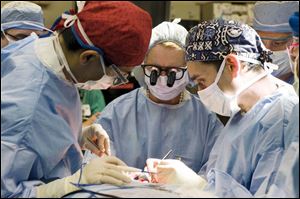
U.S. face transplant recipient suffered taunts, humiliation
12/18/2008
Dr. Risal Djohan, left, Dr. Maria Siemionow, and Dr. Daniel Alam perform a near-total face transplant at the Cleveland Clinic. Only three operations have been done worldwide.
CLEVELAND - In a basement anatomy lab, Dr. Maria Siemionow and a team of Cleveland Clinic surgeons spent weekends over the year with cadavers "a donor on one table, a recipient on another" practicing the technique of transplanting skin and underlying anatomy of a human face.
The call came in the middle of the night a few weeks ago.
They had a donor for a patient whose face was horribly disfigured, a woman traumatized by injury. Her middle face and right eye were gone. Only her upper eyelids, forehead, lower lip, and chin were left. She endured taunts and humiliation.
"She was called names," Dr. Siemionow said yesterday. "Children were afraid of her.
They were running away."
Dr. Siemionow, a Polish immigrant who worked 20 years for this moment, was nervous. Despite all the research and training, only three face transplants had been done worldwide. This was said to be the largest and most complex. Lots could go wrong.
Over 9 hours and 10 minutes, surgeons removed the donor's face, arteries, nerves, tissue, and bone. In a nearby operating room, doctors connected blood vessels of the donated graft to the patient. After hours of microsurgery, they released the clamps.
Doctors watched as the graft turned from white to pink, signaling good blood circulation. Dr. Siemionow knew they were over the hump.
She recounted the 23-hour operation yesterday as the first face transplant in the United States was explained to an international media audience.
"I'm very pleased and emotional today to share with you that we finally did it," said Dr. Siemionow, who answered questions while fiddling with her glasses.
Doctors said the patient is recovering in the hospital. It could take a year for function to return to most of her face. She is swollen, but has shown no signs of immune rejection.
With limited vision, she happily used her hands to feel her new face, doctors said. She communicates mostly in writing.
The clinic said because of patient confidentiality, it could not release her identity, the nature of her injury, or the date of the operation. The hospital had screened about 17 candidates for face transplant in the last several years, a process that involved detailed psychological evaluation, before proceeding with the transplant.
U.S. military officials paid close attention to the operation. The military is collaborating with the clinic on treating service members maimed in Iraq and Afghanistan.
The effort is part of a $42 million Defense Department grant to 16 institutions to help severely disfigured veterans.
A medical officer from the Brooke Army Medical Center at Fort Sam Houston in Texas was in Cleveland recently to discuss face transplantation. Clinic officials said they do not have a second operation planned. But a source said two soldiers and a Marine in their 20s have been identified as possible candidates.
Face transplantation has been controversial because some doctors and ethicists believed the risks of immune rejection and other complications were unknown. Doctors say tissue rejection can be reversed if caught quickly. None of the three face- transplant recipients - two in France and one in China - has suffered chronic rejection.
The patient will take anti-rejection drugs for the rest of her life, the hospital said.
In a prepared statement, the woman's sibling thanked the donor and the hospital. "We never thought for a moment that our sister would ever have a chance at a normal life again."